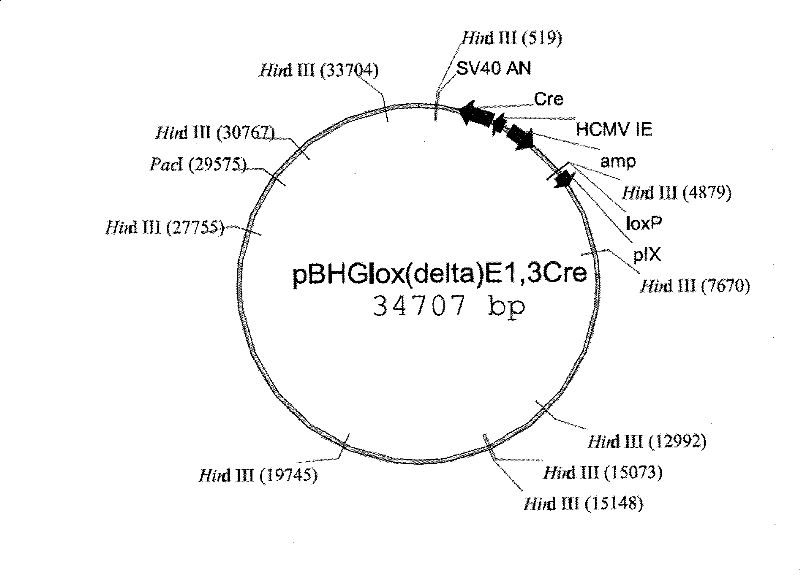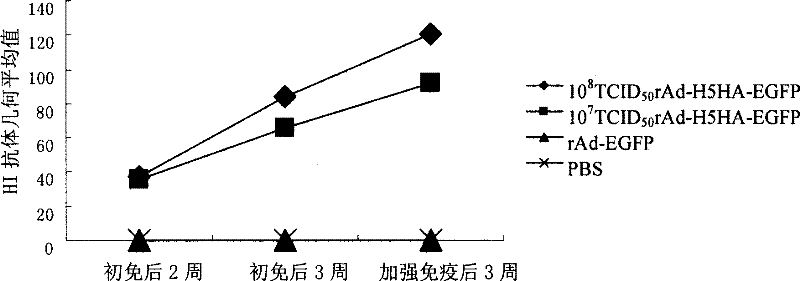Recombinant replication-defective adenoviral vector H5N1 subtype influenza genetic engineering vaccine
A genetically engineered vaccine, replication-deficient technology, applied in the field of recombinant genetically engineered vaccines, can solve problems such as high production costs, single administration method, and dependence on transportation and storage
- Summary
- Abstract
- Description
- Claims
- Application Information
AI Technical Summary
Problems solved by technology
Method used
Image
Examples
Embodiment 1
[0036] Example 1: Construction of recombinant replication-deficient adenovirus expressing influenza virus A / Swine / Fujian / 1 / 2001 (H5N1) HA gene of the present invention
[0037] A. Obtaining the immunogen
[0038] A / Swine / Fujian / 1 / 2001 (H5N1) (purchased from the Animal Influenza Laboratory of the Ministry of Agriculture, Harbin Veterinary Research Institute) was proliferated in SPF chicken embryos (purchased from the Experimental Animal Center of Harbin Veterinary Research Institute) for 48 hours, and the allantoic fluid was harvested , adding Trizol reagent (Gibco BRL) to extract RNA, and using universal primer uni12 (sequence: 5'-AGCAAAAGCAGG-3') to reverse transcribe to obtain influenza virus HA gene cDNA.
[0039] B. Preparation, collection and verification of recombinant adenovirus rAd-H5HA-EGFP Using the cDNA obtained in the above A as a template to amplify the HA gene by polymerase chain reaction (PCR), the primers used: upstream primer HAF: 5'CCC GTC GAC ATG GAGAAA ATA...
Embodiment 2
[0043]Example 2 Proliferation and purification of rAd-H5HA-EGFP
[0044] When the HEK293 cells grew to 80%-90% saturated, the recombinant virus rAd-H5HA-EGFP was inoculated at a multiplicity of infection m.o.i=5-10. After 3-4 days, when the cell lesion reaches 70-90%, collect the cell solution in a centrifuge tube, centrifuge at 3500g for 15 minutes to harvest the cells, transfer the supernatant to a sterile beaker for storage, and use 10ml of the supernatant to resuspend the cell pellet Break the cell pellet 3 times in a freeze-thaw water bath at -80°C / 25°C (the maximum water temperature of the water bath should not exceed 25°C), centrifuge again at 3500g for 15 minutes to remove cell debris, separate the supernatant and mix it with the retained supernatant, reconstitute The purification process of the virus was carried out according to the AdenoPACK adenovirus purification kit of Sartorius AG TM 100RT instructions, the obtained recombinant virus was aliquoted and frozen at ...
Embodiment 3
[0045] Example 3 Determination of rAd-H5HA-EGFP infectious titer (TCID 50 )
[0046] Take one T75 cell flask of HEK293 cells pre-cultured with culture medium (Dulbecco's Modified Eagle Media, DMEM for short) + 10% FBS (fetal bovine serum), wait until the cells grow to 80%, collect the cells and digest the cells with trypsin And count. Prepare cell suspension in DMEM with 5% FBS, each plate needs 11mL with a concentration of 1×10 5 / mL of cell suspension. Press 100μL per well (ie about 1×10 4 cells) into a 96-well plate (add another 96-well plate if a set of replicate experiments is to be performed). Dilute the adenovirus sample by aseptic operation: take 10 μL of high-concentration recombinant adenovirus solution for serial 10-fold dilution, and use DMEM with 5% FBS as the diluent. Do another set of repeated experiments, and then carry out the second set of dilutions according to the above steps. The detection process adopts the rapid adenovirus infectious titer (TCID) p...
PUM
| Property | Measurement | Unit |
|---|---|---|
| molecular weight | aaaaa | aaaaa |
Abstract
Description
Claims
Application Information
 Login to View More
Login to View More - R&D
- Intellectual Property
- Life Sciences
- Materials
- Tech Scout
- Unparalleled Data Quality
- Higher Quality Content
- 60% Fewer Hallucinations
Browse by: Latest US Patents, China's latest patents, Technical Efficacy Thesaurus, Application Domain, Technology Topic, Popular Technical Reports.
© 2025 PatSnap. All rights reserved.Legal|Privacy policy|Modern Slavery Act Transparency Statement|Sitemap|About US| Contact US: help@patsnap.com



